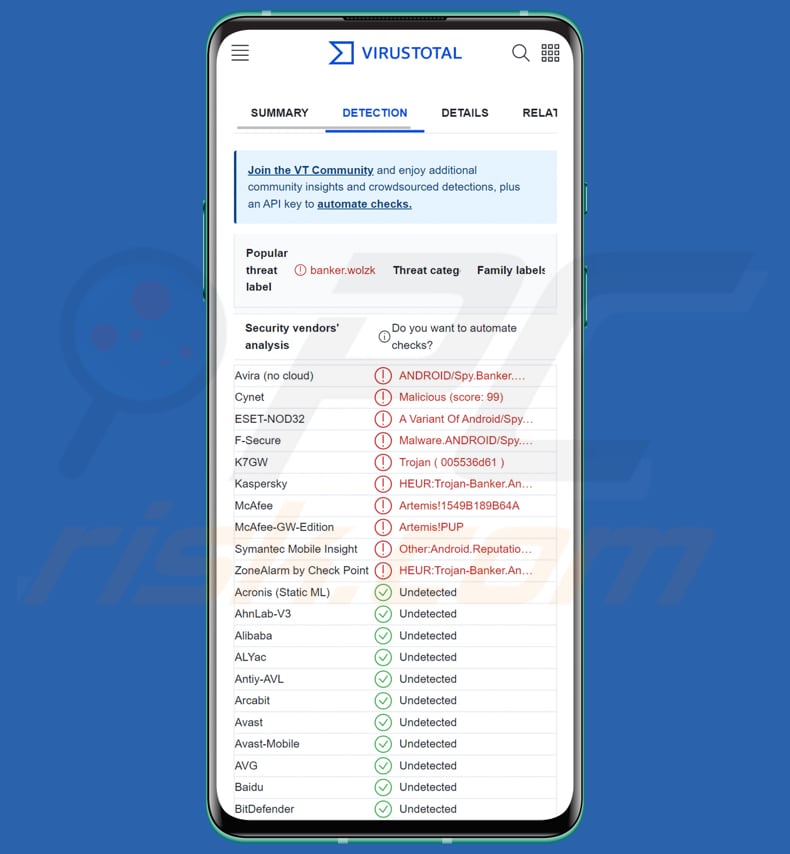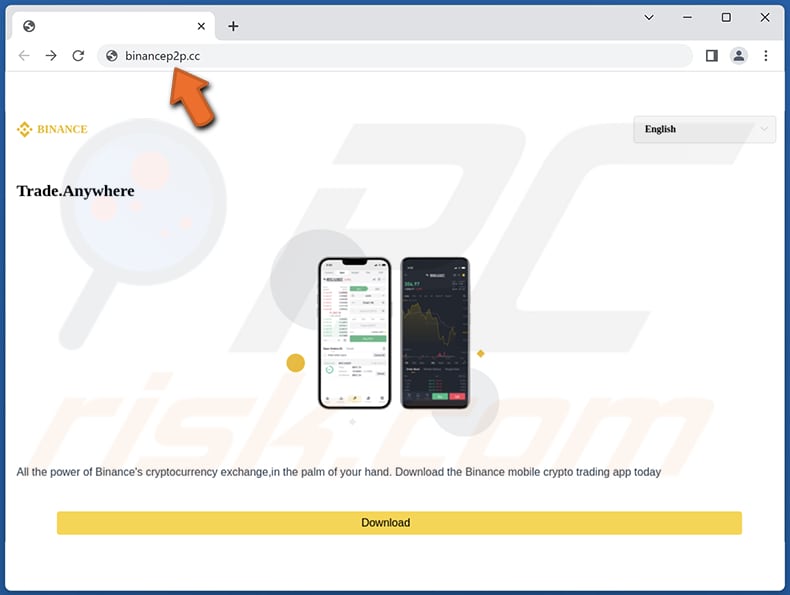How to remove Remo banking Trojan
![]() Written by Tomas Meskauskas on (updated)
Written by Tomas Meskauskas on (updated)
What kind of malware is Remo?
Remo is an Android banking Trojan that exploits the Accessibility service to illicitly acquire sensitive data. This malicious software specifically focuses on over 50 banking and cryptocurrency wallet applications. Remo primarily directs its attacks toward banking applications in the regions of Vietnam and India.

Remo banking Trojan overview
Remo uses strong techniques to make it difficult to reverse engineer, and it encrypts the strings within its files. After installation, Remo connects to a C&C server to obtain a list of specific banking and cryptocurrency wallet apps it plans to attack. This list contains details like the app's ID, package name, name, and whether it's disabled or not.
Once it acquires the list of targeted apps, the malware checks if these apps are installed on the compromised device. It then sends each targeted app's names, package names, and version numbers to the C&C server. At the same time, Remo asks the victim to enable the Accessibility service.
Once this service is activated, Remo misuses it to carry out banking Trojan actions, hinder uninstallation, and gain automatic permissions. Also, the malware constantly sends various information from the infected device to the C&C server.
This data includes details like whether the Accessibility service is active, the name of the currently active app, clipboard data, time zone settings, and basic device information. Notably, the malware consistently collects clipboard content, allowing it to obtain sensitive data from the infected device without needing explicit permissions.
Once the victim grants permission for the Accessibility service, the malware uses it to find the specific banking or cryptocurrency wallet apps on the victim's device. When the malware detects the victim using any of these apps, it takes a screenshot of all text currently displayed on the screen.
The attacker can use the stolen information to extract credentials and other sensitive data from the targeted application.
The Remo malware also keeps an eye on the text input fields in the targeted apps (it logs keystrokes) and sends any sensitive information entered by the victim to the C&C server. Furthermore, this malware also pilfers all the contacts saved on the compromised device.
| Name | Remo banking Trojan |
| Threat Type | Android malware, malicious application, unwanted application. |
| Detection Names | Avira (ANDROID/Spy.Banker.wolzk), Cynet (Malicious (score: 99)), ESET-NOD32 (A Variant Of Android/Spy.Banker.BZD), Kaspersky (HEUR:Trojan-Banker.AndroidOS.Agent.md), Full List (VirusTotal) |
| Symptoms | The device is running slow, system settings are modified without user's permission, questionable applications appear, data and battery usage is increased significantly, browsers redirect to questionable websites, intrusive advertisements are delivered. |
| Distribution methods | Fake Binance and other websites, infected email attachments, malicious online advertisements, social engineering, deceptive applications. |
| Damage | Stolen personal information, decreased device performance, battery is drained quickly, decreased Internet speed, huge data losses, monetary losses, stolen identity (malicious apps might abuse communication apps). |
| Malware Removal (Android) | To eliminate possible malware infections, scan your mobile device with legitimate antivirus software. Our security researchers recommend using Combo Cleaner. |
Conclusion
Remo can inflict substantial harm on its victims by compromising their personal and financial security. It can steal sensitive data, including login credentials and personal information, from targeted banking and cryptocurrency wallet applications.
Additionally, Remo's control over Accessibility services and text input fields allows it to intercept and transmit sensitive information the victim enters, potentially leading to identity theft and financial fraud. Moreover, its presence can result in a compromised overall device performance, undermining the victim's digital experience.
More examples of Android malware are MMRat, CraxsRAT, and CherryBlos.
How did Remo infiltrate my device?
Cybercriminals try to trick users into installing Remo banking Trojan using a fake Binance cryptocurrency website. They set up a fake website that looks just like the real one and offers a file to download, but this file is actually Remo. It is also suspected that at least two other websites are involved in spreading Remo.
Threat actors may also send links to these fake websites through text messages or messaging apps, hoping to catch users off guard and get them to download the harmful software without realizing it.
How to avoid installation of malware?
To stay safe, stick to trusted sources like the official pages and Google Play Store when getting apps. Always read reviews and ratings before downloading. Also, keep your device and apps up to date for the latest security fixes. Avoid clicking ads, links, or pop-ups on sketchy websites.
When giving apps permissions, be careful, check them closely, and do not give them more access than they need. Think about using good antivirus or security apps to scan for and stop malware on your device.
Screenshot of the fake Binance website used to distribute Remo malware:

The list of known apps targeted by Remo:
- ACB
- Agribank
- allo bank
- Bitpie Wallet
- BIDV
- Binance
- BSI Mobile
- Bualuang mBanking
- BRILink Mobile
- Digibank Indonesia
- HDBank
- imtoken
- Input
- Jago
- KBZPay
- K PLUS
- Livin’ by Mandiri
- MetaMask
- MOMO
- MSB
- myBCA
- NEXT
- OCB
- OKX
- PermataMobile X
- Sacombank
- SeaBank
- SCB EASY
- Techcombank
- Ttb Touch
- TPBank
- UOB TMRW
- VCBB
- VietinBank
- Viettel Money
- Vitien
- VPBank
- ZaloPay
Quick menu:
- Introduction
- How to delete browsing history from the Chrome web browser?
- How to disable browser notifications in the Chrome web browser?
- How to reset the Chrome web browser?
- How to delete browsing history from the Firefox web browser?
- How to disable browser notifications in the Firefox web browser?
- How to reset the Firefox web browser?
- How to uninstall potentially unwanted and/or malicious applications?
- How to boot the Android device in "Safe Mode"?
- How to check the battery usage of various applications?
- How to check the data usage of various applications?
- How to install the latest software updates?
- How to reset the system to its default state?
- How to disable applications that have administrator privileges?
Delete browsing history from the Chrome web browser:

Tap the "Menu" button (three dots on the right-upper corner of the screen) and select "History" in the opened dropdown menu.

Tap "Clear browsing data", select "ADVANCED" tab, choose the time range and data types you want to delete and tap "Clear data".
Disable browser notifications in the Chrome web browser:

Tap the "Menu" button (three dots on the right-upper corner of the screen) and select "Settings" in the opened dropdown menu.

Scroll down until you see "Site settings" option and tap it. Scroll down until you see "Notifications" option and tap it.

Find the websites that deliver browser notifications, tap on them and click "Clear & reset". This will remove permissions granted for these websites to deliver notifications. However, once you visit the same site again, it may ask for a permission again. You can choose whether to give these permissions or not (if you choose to decline the website will go to "Blocked" section and will no longer ask you for the permission).
Reset the Chrome web browser:

Go to "Settings", scroll down until you see "Apps" and tap it.

Scroll down until you find "Chrome" application, select it and tap "Storage" option.

Tap "MANAGE STORAGE", then "CLEAR ALL DATA" and confirm the action by taping "OK". Note that resetting the browser will eliminate all data stored within. This means that all saved logins/passwords, browsing history, non-default settings and other data will be deleted. You will also have to re-login into all websites as well.
Delete browsing history from the Firefox web browser:

Tap the "Menu" button (three dots on the right-upper corner of the screen) and select "History" in the opened dropdown menu.

Scroll down until you see "Clear private data" and tap it. Select data types you want to remove and tap "CLEAR DATA".
Disable browser notifications in the Firefox web browser:

Visit the website that is delivering browser notifications, tap the icon displayed on the left of URL bar (the icon will not necessarily be a "Lock") and select "Edit Site Settings".

In the opened pop-up opt-in the "Notifications" option and tap "CLEAR".
Reset the Firefox web browser:

Go to "Settings", scroll down until you see "Apps" and tap it.

Scroll down until you find "Firefox" application, select it and tap "Storage" option.

Tap "CLEAR DATA" and confirm the action by taping "DELETE". Note that resetting the browser will eliminate all data stored within. This means that all saved logins/passwords, browsing history, non-default settings and other data will be deleted. You will also have to re-login into all websites as well.
Uninstall potentially unwanted and/or malicious applications:

Go to "Settings", scroll down until you see "Apps" and tap it.

Scroll down until you see a potentially unwanted and/or malicious application, select it and tap "Uninstall". If, for some reason, you are unable to remove the selected app (e.g., you are prompted with an error message), you should try using the "Safe Mode".
Boot the Android device in "Safe Mode":
The "Safe Mode" in Android operating system temporarily disables all third-party applications from running. Using this mode is a good way to diagnose and solve various issues (e.g., remove malicious applications that prevent users you from doing so when the device is running "normally").

Push the "Power" button and hold it until you see the "Power off" screen. Tap the "Power off" icon and hold it. After a few seconds the "Safe Mode" option will appear and you'll be able run it by restarting the device.
Check the battery usage of various applications:

Go to "Settings", scroll down until you see "Device maintenance" and tap it.

Tap "Battery" and check the usage of each application. Legitimate/genuine applications are designed to use as low energy as possible in order to provide the best user experience and to save power. Therefore, high battery usage may indicate that the application is malicious.
Check the data usage of various applications:

Go to "Settings", scroll down until you see "Connections" and tap it.

Scroll down until you see "Data usage" and select this option. As with battery, legitimate/genuine applications are designed to minimize data usage as much as possible. This means that huge data usage may indicate presence of malicious application. Note that some malicious applications might be designed to operate when the device is connected to wireless network only. For this reason, you should check both Mobile and Wi-Fi data usage.

If you find an application that uses a lot of data even though you never use it, then we strongly advise you to uninstall it as soon as possible.
Install the latest software updates:
Keeping the software up-to-date is a good practice when it comes to device safety. The device manufacturers are continually releasing various security patches and Android updates in order to fix errors and bugs that can be abused by cyber criminals. An outdated system is way more vulnerable, which is why you should always be sure that your device's software is up-to-date.

Go to "Settings", scroll down until you see "Software update" and tap it.

Tap "Download updates manually" and check if there are any updates available. If so, install them immediately. We also recommend to enable the "Download updates automatically" option - it will enable the system to notify you once an update is released and/or install it automatically.
Reset the system to its default state:
Performing a "Factory Reset" is a good way to remove all unwanted applications, restore system's settings to default and clean the device in general. However, you must keep in mind that all data within the device will be deleted, including photos, video/audio files, phone numbers (stored within the device, not the SIM card), SMS messages, and so forth. In other words, the device will be restored to its primal state.
You can also restore the basic system settings and/or simply network settings as well.

Go to "Settings", scroll down until you see "About phone" and tap it.

Scroll down until you see "Reset" and tap it. Now choose the action you want to perform:
"Reset settings" - restore all system settings to default;
"Reset network settings" - restore all network-related settings to default;
"Factory data reset" - reset the entire system and completely delete all stored data;
Disable applications that have administrator privileges:
If a malicious application gets administrator-level privileges it can seriously damage the system. To keep the device as safe as possible you should always check what apps have such privileges and disable the ones that shouldn't.

Go to "Settings", scroll down until you see "Lock screen and security" and tap it.

Scroll down until you see "Other security settings", tap it and then tap "Device admin apps".

Identify applications that should not have administrator privileges, tap them and then tap "DEACTIVATE".
Frequently Asked Questions (FAQ)
My computer is infected with Remo malware, should I format my storage device to get rid of it?
When dealing with a Remo malware infection on your device, one potential solution is to format your storage device. However, it is essential to note that this will result in the complete erasure of all data on the device. As an alternative to formatting, you might consider using trusted antivirus software like Combo Cleaner to attempt malware removal.
What are the biggest issues that malware can cause?
Malware can put your sensitive personal and financial data at risk, potentially leading to identity theft and financial harm. Additionally, it can disrupt your device's normal functioning, leading to system crashes, slower performance, and data damage. More advanced malware can even lock you out of your files, demanding payment for their release, resulting in data loss and financial extortion.
What is the purpose of Remo malware?
Remo aims to steal sensitive information, such as login credentials and personal data, from targeted banking and cryptocurrency wallet applications. It accomplishes this by exploiting the Accessibility service and monitoring text input fields. Additionally, Remo can capture contacts stored on the infected device.
How did Remo malware infiltrate my device?
Remo malware enters devices deceptively through fake websites resembling Binance pages. Cybercriminals use these sites to offer downloads that, unknown to users, contain Remo. Suspicions suggest at least two other sites may be involved in spreading it. Threat actors send links to these fraudulent sites via texts or messaging apps to trick users into downloading the malware.
Will Combo Cleaner protect me from malware?
Certainly, Combo Cleaner is capable of detecting and eliminating the majority of known malware. Nevertheless, certain elusive malware can be challenging to identify, so performing a full system scan is advisable to ensure you capture any potential threats.


▼ Show Discussion